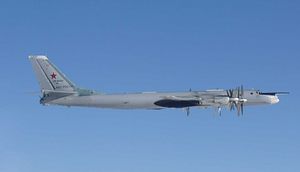Japan Air Self Defense Force (JASDF) fighters intercepted four nuclear-capable Russian Tupolev Tu-95MS strategic bombers and four Sukhoi Su-35S (Flanker-E+) multirole fighter jets flying in two separate formations over the east and west coasts of Japan on February 15, the Ministry of Defense (MoD) said in a statement. The intercepts took place in international waters and Japanese airspace was reportedly not violated.
According to the Russian National Defense Control Center, the Tu-95MS crews spent more than 15 hours in the air and carried out inflight refueling. While the Russian MoD confirmed that two Tu-95MS bombers and escort aircraft carried out a “routine flight” over the Sea of Japan, the Sea of Okhotsk and the Western Pacific on February 15, it did not acknowledge the presence of the other two bombers.
The February 15 flights constitute one of the largest single presence of Russian military aircraft near Japan since Russia resumed regular long-range patrols in East Asia in 2014 following the deterioration of Russia-Japan diplomatic relations as a result of the Russian intervention in Eastern Ukraine.
Russia usually dispatches its Tu-95MS bombers in pairs. The last exception to that took place in January 2017, when JASDF fighter jets intercepted three Russian Tu-95 strategic bombers circumnavigating the major islands — Hokkaido, Honshu, Shikoku, and Kyushu — of the Japanese archipelago.
The February 15 intercept took place after a three-and-a-half-week hiatus of Russian long-range patrols. On January 17, Japanese fighters conducted a scramble against a Russian Navy Ilyushin Il-38 “Dolphin” maritime patrol and anti-submarine warfare aircraft over the Sea of Japan. On January 16, the JASDF scrambled fighter jets to intercept two Sukhoi Su-24 nuclear-capable strike attack aircraft in the Sea of Japan. As I noted last month:
[Another] intercept of a Russian Su-24 strike attack aircraft or fighter-bomber took place in the Sea of Japan on December 19, 2018, which marked the first Russian aerial patrol in close proximity to the Japanese islands following a five-week hiatus.
A previous intercept of a Russian military plane—an Ilyushin Il-38 “Dolphin,” a maritime patrol and anti-submarine warfare aircraft—took place on November 8. Two Russian Ilyushin Il-20 maritime reconnaissance and anti-submarine warfare aircraft were also intercepted on October 19.
In December, I summarized additional JASDF scrambles against Russian aircraft in 2018:
Another intercept of a Russian air patrol that included a Sukhoi Su-35S (Flanker-E+) multirole fighter jet, one Sukhoi Su-24, and one unidentified plane over the Sea of Japan took place on September 20. The JASDF also scrambled fighter jets to intercept two nuclear-capable Russian Tupolev Tu-95MS strategic bombers and support aircraft in July. The Tu-95MS is an updated variant of the older Tu-95, a Soviet-era four-engine, long-range, turboprop, strategic bomber that can carry stand-off nuclear-capable cruise missiles.
A pair of Su-34 fighter-bombers crashed into the Sea of Japan after reportedly colliding with each other off the coast in Russia’s Far East on January 18. The fighter-bombers were reportedly unarmed and flying in close formation. Additionally, a Russian Air Force Tupolev Tu-22M3 supersonic bomber crashed at Olenegorsk airbase, in Russia’s northwestern region of Murmansk killing three crew members, on January 22.































